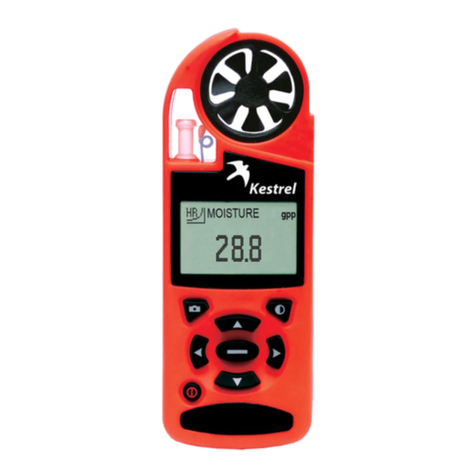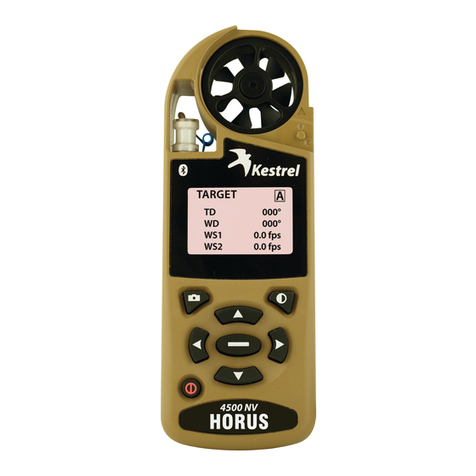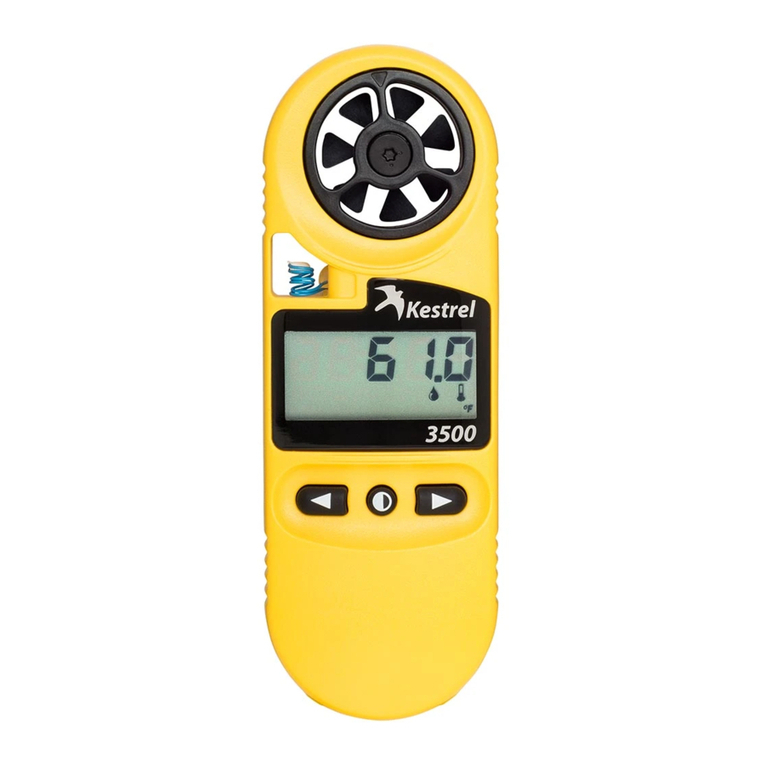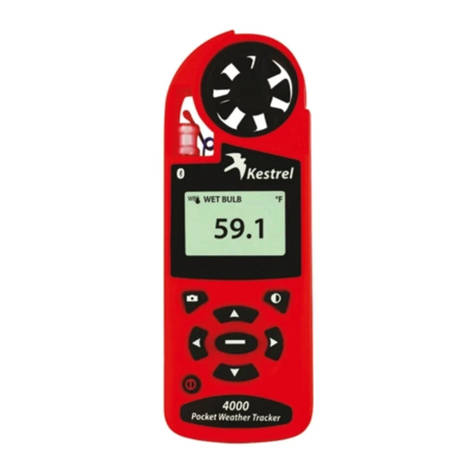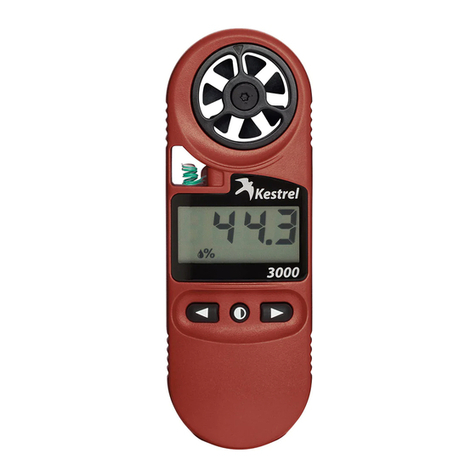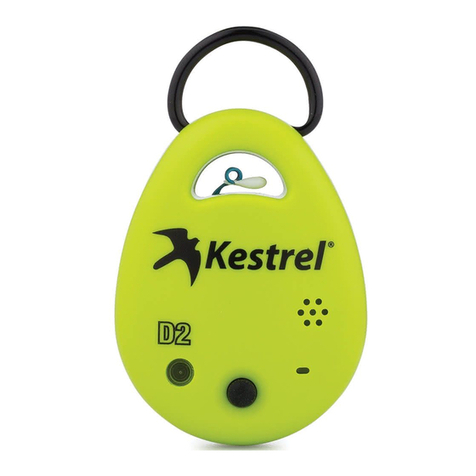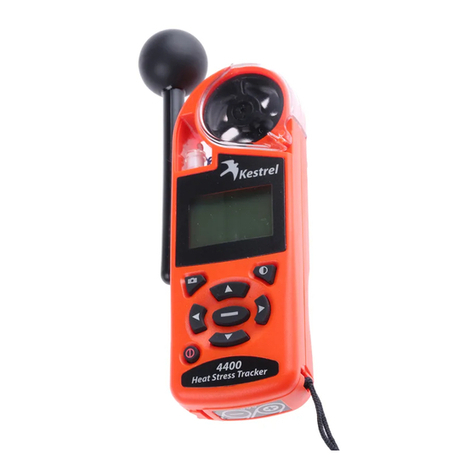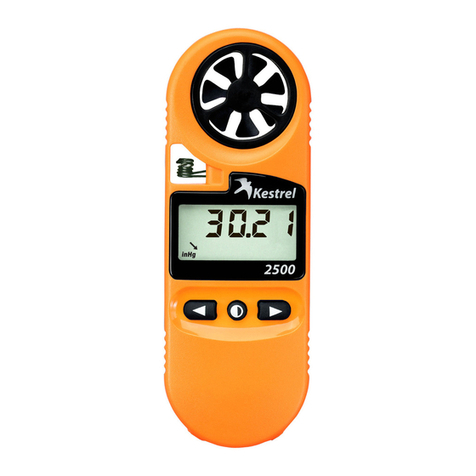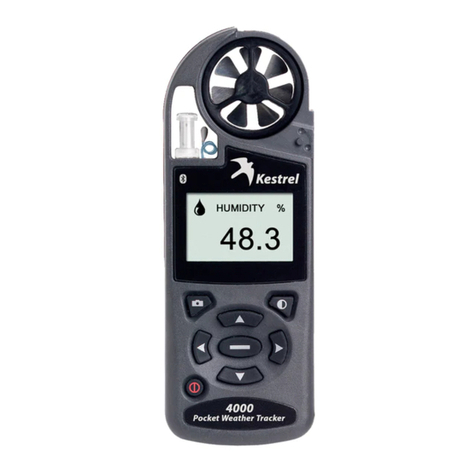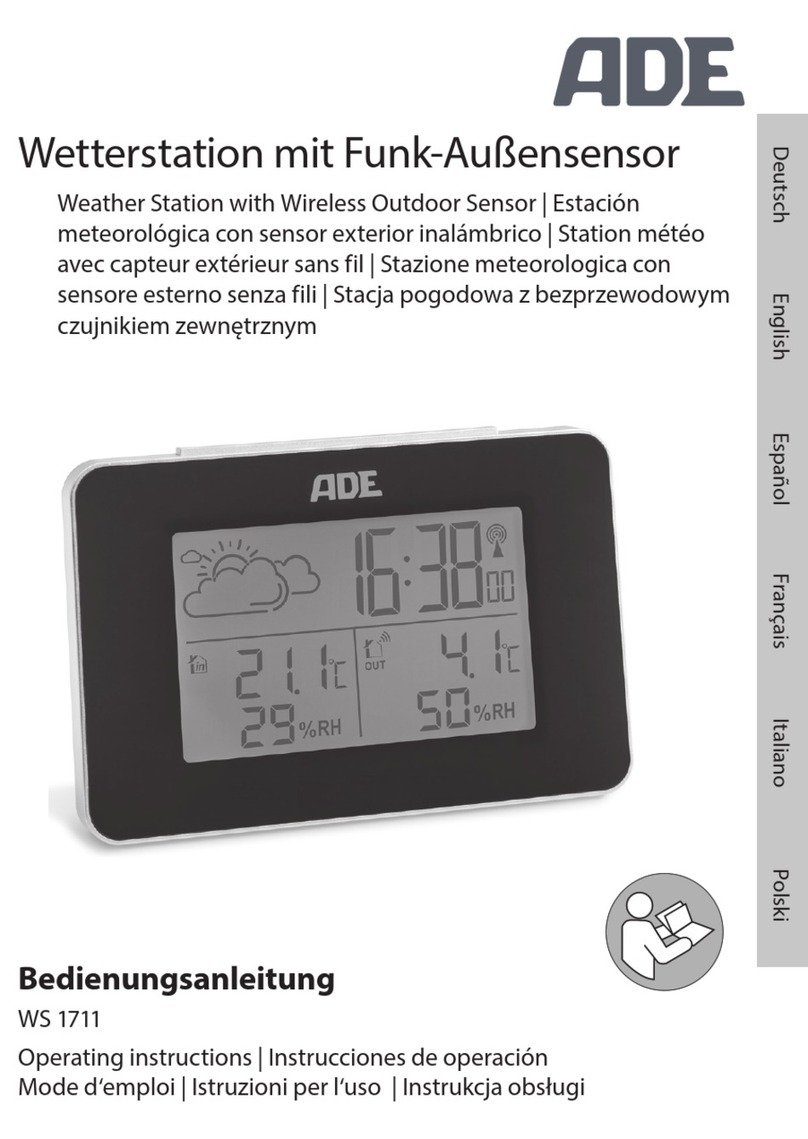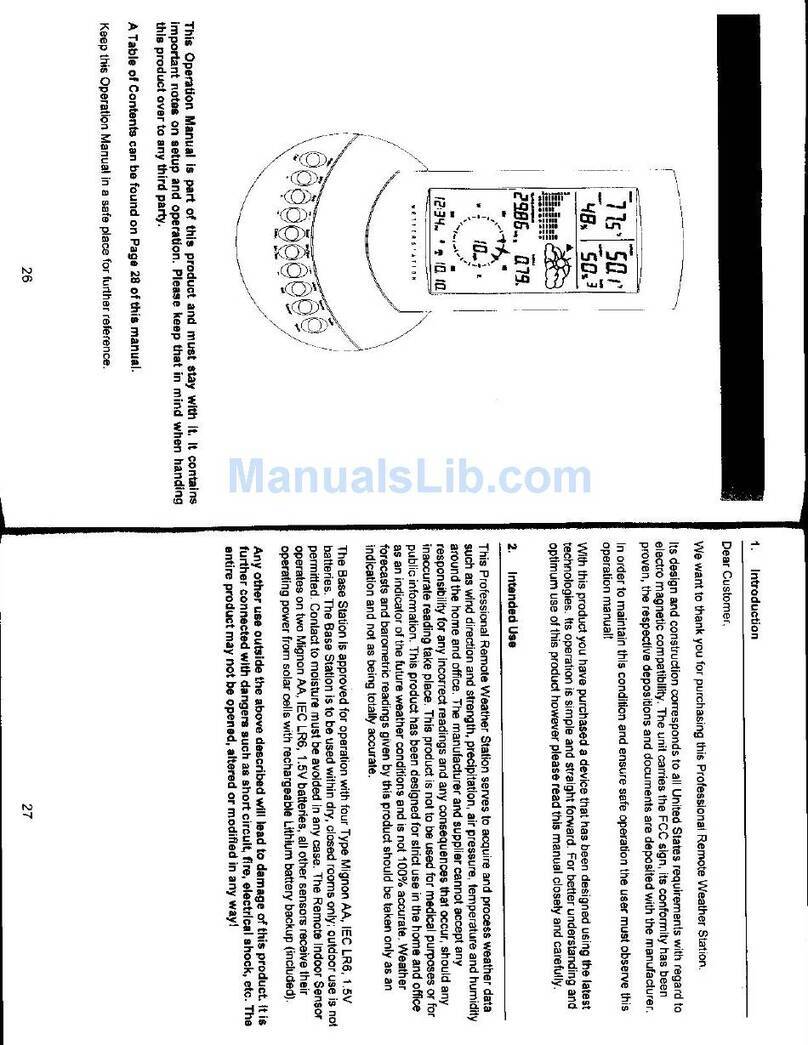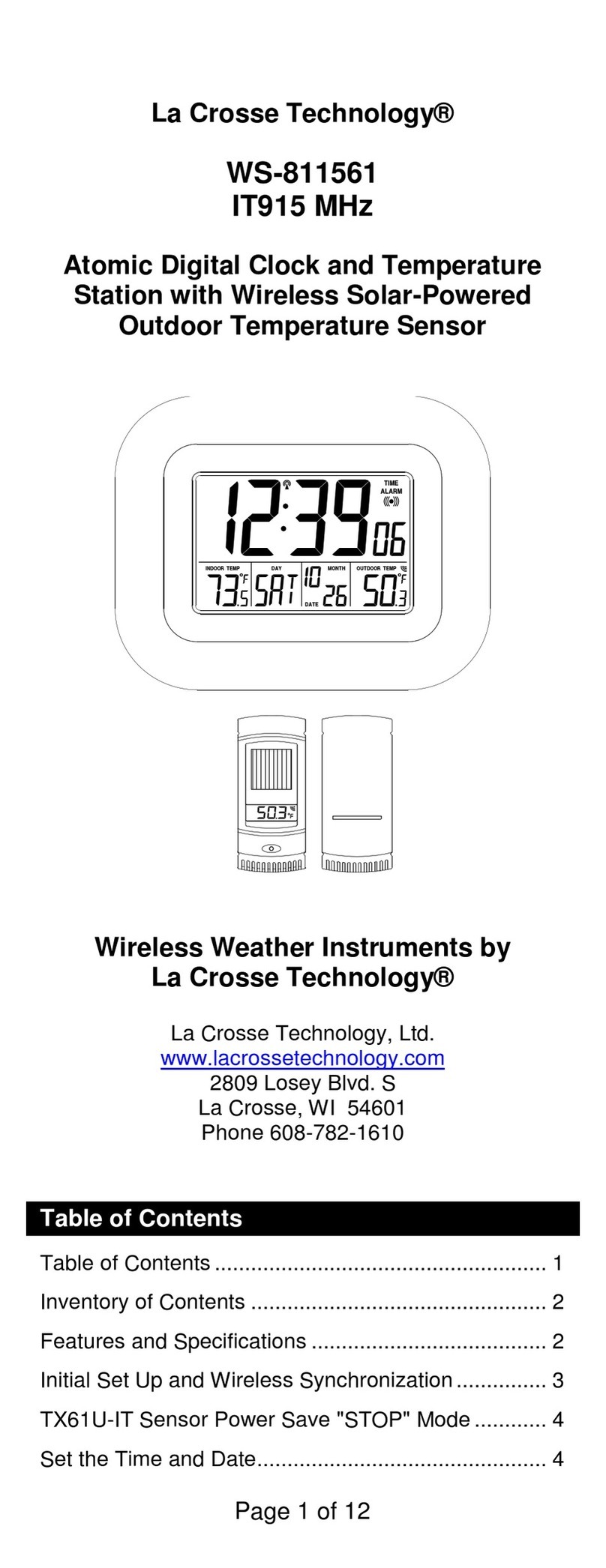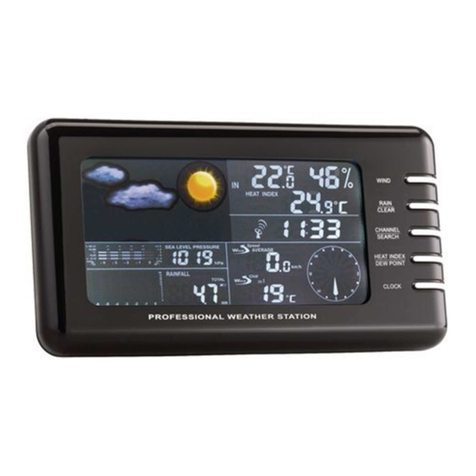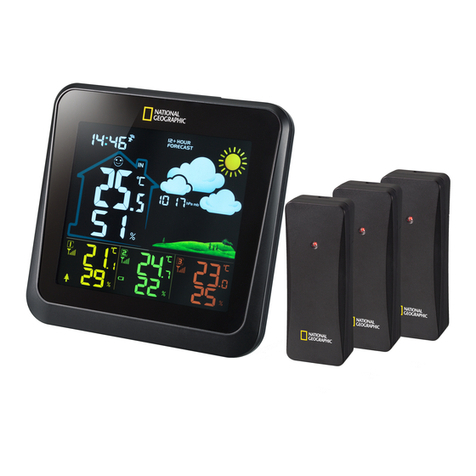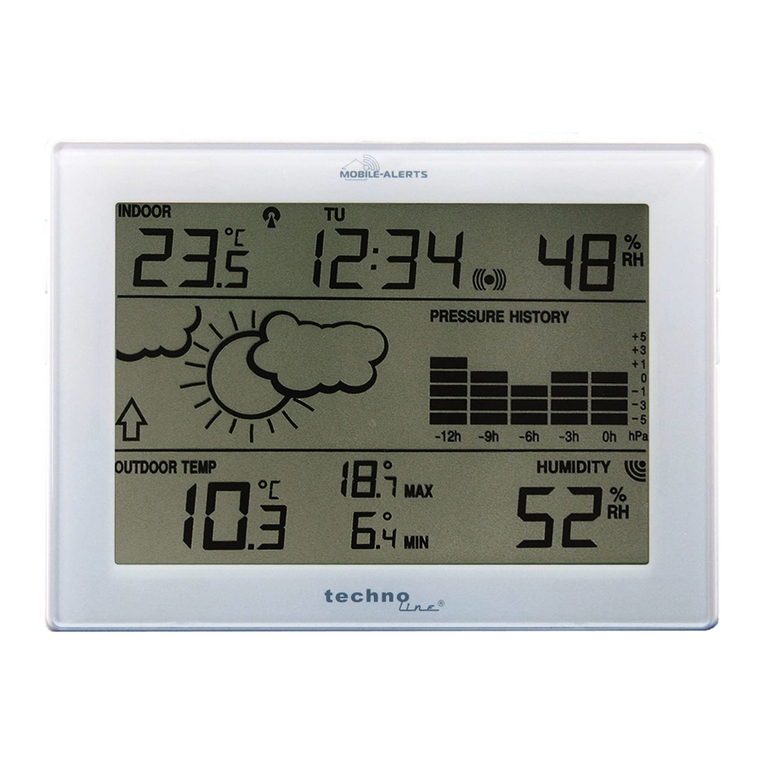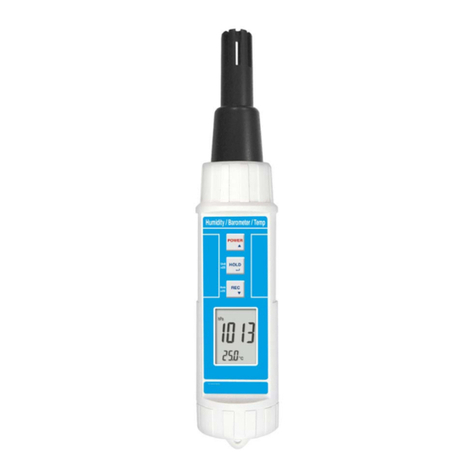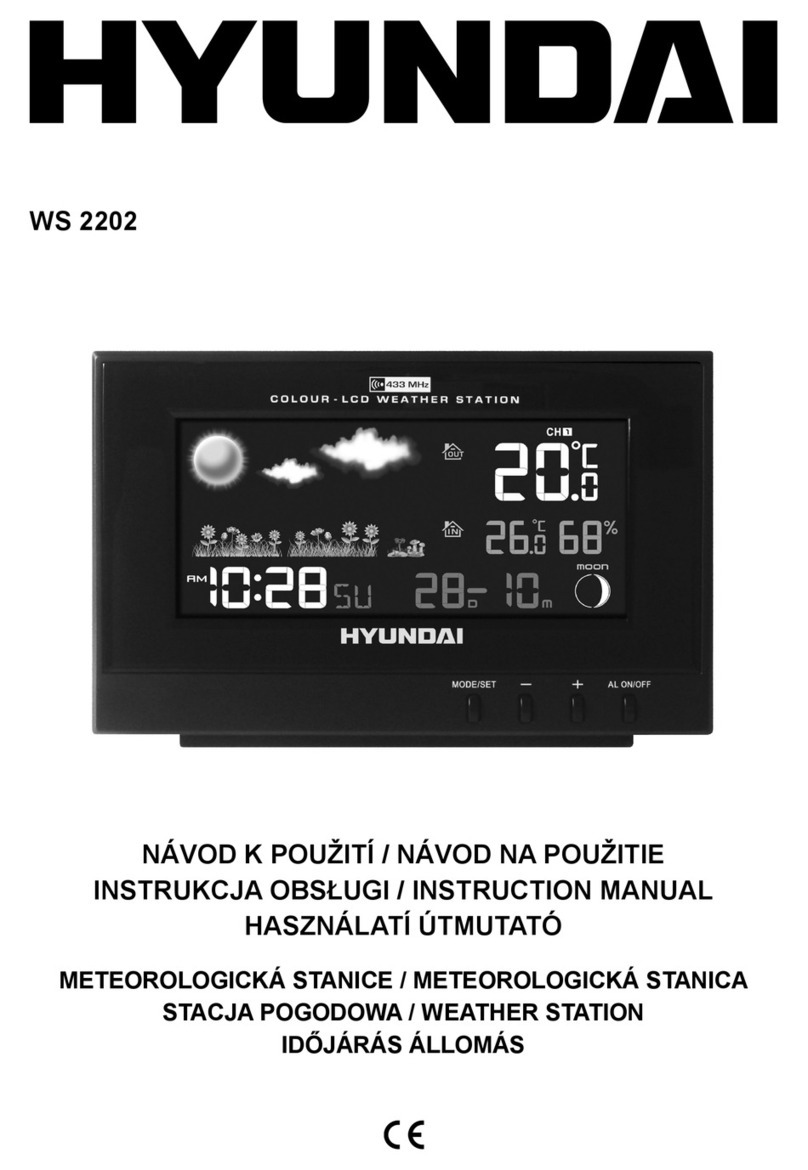
Thank you for purchasing the Kestrel 3500 Pocket Weather Meter.This instrument will
measure the following environmental conditions:
• wind speed • heat stress index
• maximum wind gust • dewpoint
• average wind speed • wet bulb temperature
• temperature (air,water snow) • barometric pressure
• wind chill • altitude
• relative humidity
Plus additional features:
• clock • 3-hour pressure trend
• data hold function • backlight
• automatic power-down function
OPERATION
1) Slide off cover.
2) Turn on. Press the center button ( ) to turn on the unit.
3) Select measurement. Press the right arrow ( ) to scroll through the measurements
listed below. Press the left arrow ( ) to scroll through the measurements in reverse order.
The instantaneous measurements will be displayed. Each measurement screen is
preceded by a brief hint to clarify which measurement is being displayed. (See
Understanding the Measurements section for more information.)
4) Select the unit of measure. While holding , press to scroll through the units of
measure listed below.
Mode Hint Icon Units of Measure
Clock --- --- 12-hr, 24-hr
Wind Speed SPd m/s, ft/min, km/h, mph, kt, B
Max Gust SPd MAX m/s, ft/min, km/h, mph, kt, B
Avg Speed SPd AVG m/s, ft/min, km/h, mph, kt, B
Temperature dEG C,F
Wind Chill chill C,F
Humidity r.h. %
Heat Stress Index H.I. C,F
Dewpoint d.P. C,F
Wet Bulb Temp bulb C,F
Barometric Pressure* bAro hPa, inHg
Altitude Alt m, ft
* Only one of the pressure icons will be displayed, indicating the 3-hour pressure trend.
pressure rising quickly (rise more than +0.18 inHg)
pressure rising (rise within +0.06 inHg and +0.18 inHg)
pressure stable (remain within -0.06 and +0.06 inHg)
pressure falling (drop within -0.06 inHg and -0.18 inHg)
pressure falling quickly (drop more than -0.18 inHg)
5) Hold mode. While holding , press to hold the time and all of the measured values.
The word“HOLD” will blink to indicate the Hold Mode. Press or to view the other
measurements in Hold Mode. While holding , press to exit the Hold Mode. This mode
can be useful for taking measurements when unable to view the display.
6) Turn on the backlight. Press to activate the backlight for 10 seconds. If or are
pressed while the backlight is illuminated, the backlight will remain illuminated for another
10 seconds. Press while the backlight is illuminated to manually turn off the backlight.
7) Adjust the clock. Simultaneously press and to adjust the clock. While the clock
is blinking, press or to adjust the clock. Hold or to adjust the times quickly.
Simultaneously press and to exit the clock adjustment.
8) Adjust the reference altitude. Obtain your altitude from a topographic map or
landmark to use as your reference altitude. From the barometric pressure screen,
simultaneously press and buttons to adjust the reference altitude. Press or to
adjust the reference altitude, or hold or to adjust the value quickly. Simultaneously
press and to exit the reference altitude adjustment.
9) Adjust the reference pressure. Obtain your barometric pressure reading from a
local weather source to use as your reference pressure. From the altitude screen,
simultaneously press and buttons to adjust the reference pressure. Press or to
adjust the reference pressure, or hold or to adjust the value quickly. Simultaneously
press and to exit the reference pressure adjustment.
10)Turn off. Hold for 2 seconds to manually turn off the unit. The unit will automatically
turn off if no buttons have been pressed for 45 minutes.
UNDERSTANDING THE MEASUREMENTS
Wind Speed - average over the previous three seconds. The measurement will be
accurate for air flow through the front or rear of the unit.
Maximum Wind Gust - maximum 3 - second wind speed since the unit was turned on.
Average Wind Speed - average wind speed since the unit was turned on.
Temperature - instantaneous temperature of the thermistor,which is located at the end
of the long coiled leads in the open cavity below the impeller.The exposed thermistor will
respond quickly to changes in temperature when air flows past it. For fastest response,
either hold the unit into the wind or wave the unit side to side for 15 seconds. Readings
should be taken in the shade. Water and snow temperatures can be taken by hold the
unit in the water or snow.
Wind Chill - combination of wind speed and temperature, as defined by the US National
Weather Service. Wind chill is the effective temperature on a human or animal at low
temperatures due to wind speed. Wind chill readings will be the same as the temperature
readings above 45ºF or below 3 mph.
Relative Humidity - amount of moisture in the air compared to the amount of moisture
the air can hold for the given temperature, represented as a percent. Because relative
humidity is also a function of the temperature, the response time will be dependent on
the temperature response time (see temperature section above). Readings should be
taken in the shade.
Heat Stress – combination of temperature and humidity, as defined by the US National
Weather Service. Heat stress is the effective temperature on a human or animal at high
temperatures due to humidity. Heat stress readings will be the same as the temperature
readings below 70ºF.
Dewpoint – calculated based on temperature and humidity measurements, as a
measure of moisture content in the air.If the dewpoint is very close to the temperature,
the air is humid. If the temperature and dewpoint are the same, dew will form. If this
happens below freezing, frost will form.
Wet Bulb Temperature - calculated based on temperature and humidity measurements,
as a measure of evaporation rate. If the wet bulb temperature is very close to the air
temperature, the air is humid. Wet bulb temperature is typically measured by swinging
a mercury thermometer with a wet sock on its end for several minutes.
Altitude and Barometric Pressure - the Kestrel 3500 will measure station pressure in
order to calculate barometric pressure and altitude. Changes in either air pressure or
altitude will affect these readings,so it’s important to make adjustments as necessary.
First, you will need to obtain either (a) the current barometric pressure or (b) the altitude
of your location.You can obtain your current barometric pressure by contacting a local
airport or weather service. Set this value as your reference pressure on the ALTITUDE
screen to determine your altitude. Otherwise, you can obtain your altitude from a
topographic map or local landmark. Set this value as your reference altitude on the
BAROMETRIC PRESSURE screen to determine your barometric pressure.
There are two examples for when and how to use the BAROMETRIC PRESSURE and
ALTITUDE screens. First, assume that you know the altitude from one of the sources
above. Set the reference altitude on the BAROMETRIC PRESSURE screen to this elevation.
As long as you remain at home, you can accurately track changes in the barometric
pressure.However,the measurement on the ALTITUDE screen also changes.This value
will fluctuate as pressure fronts pass through your location. Since you know your house
in not changing elevation, you can ignore this screen.
Now let’s assume that you are planning a day hike and you’d like to track your altitude.
Before starting,you’ll need to adjust the reference pressure on the ALTITUDE screen.You
can do this by simply adjusting the reference pressure until you reach the elevation of
your house. The reference pressure will be the same as the pressure reading on the
BAROMETRIC PRESSURE screen.You can now track the altitude as you hike.You can ignore
the values on the BAROMETRIC PRESSURE screen, since the pressure changes are
predominantly due to changes in elevation.
As with all pressure altimeters, it must be assumed that any change in pressure due to
weather is small over the course of one day. If you were to encounter an elevation landmark,
you can adjust the reference pressure until the altitude matches the landmark elevation.
This will correct the altitude for any pressure changes due to weather.
MAINTENANCE
StoringYour Kestrel
Avoid storing your Kestrel where it will be exposed to temperatures above 80° C [176° F]
or below -30°C [-22°F] for extended periods of time. Doing so may cause permanent
damage. (Note that the inside of a car parked in the hot sun can reach very high
temperatures.)
Use of the Lanyard and Cover
The cover can be captured on the lanyard to avoid loss. First, remove the cord poplock.
Then feed the lanyard end through the large opening in the cover and out the slot.
Replace the poplock on the lanyard.
Replacing the Battery
When your display flashes the low battery indicator ( ) , replace the
battery. Use a large coin to open the battery compartment. Insert a new
CR2032 coin cell (available where watch batteries are sold), positive (+)
pole up. When replacing the battery door, be sure to keep the black
rubber o-ring seated in the groove on the case back.
+
CR2032
3V
!
CR2032
Battery
A
s
s
e
m
b
l
e
d
i
n
U
S
A
Kestrel®
3500
Pocket Weather™Meter
with Backlight
Thank you for purchasing a Kestrel Pocket Weather Meter! Please register your
Kestrel within 10 days of receipt to activate your warranty coverage. (If product
is not registered, two-year warranty coverage will start on date of manufacture.)
This information will be kept confidential. Any information collected about our
customers will not be sold or distributed, and will be used for the business of Nielsen-Kellerman only. We
are conducting this survey in order to improve the quality of our product. Thank you for your cooperation
and we appreciate your time.
The team at Nielsen-Kellerman stands proudly behind our products. If you have any questions or comments please feel
free to call us at 1.800.784.4221 or visit our website at www.nkhome.com.
Sincerely,
Nielsen-Kellerman
Sales Department
Kestrel
Pocket Weather Meters
